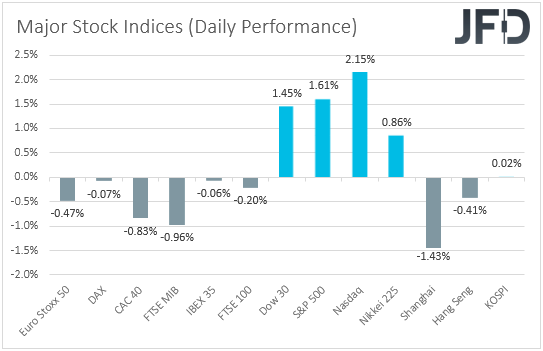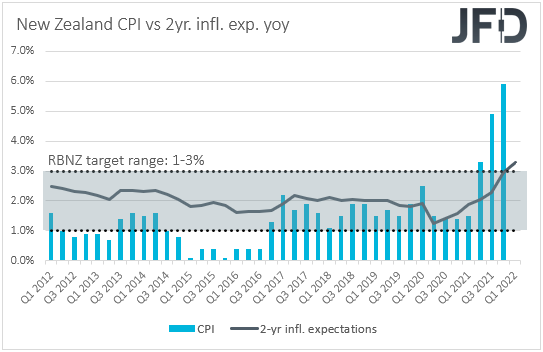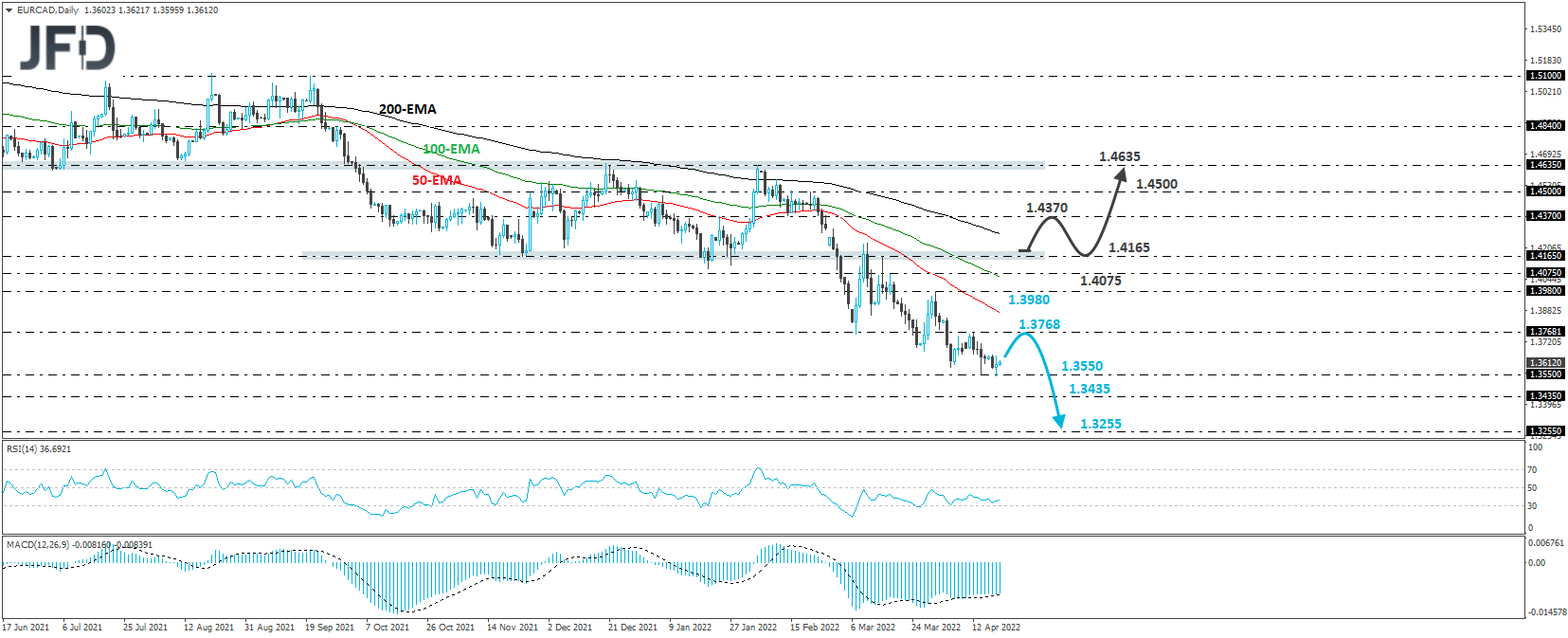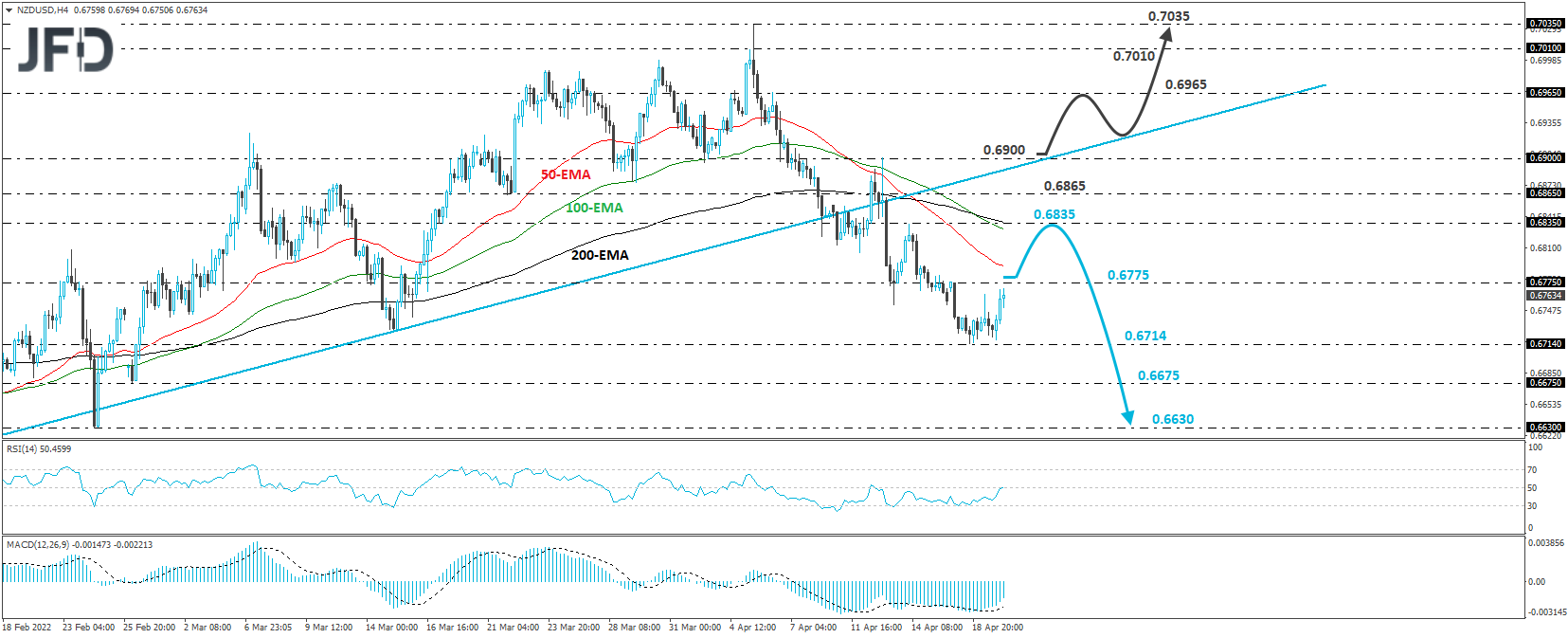The day – and night – ahead of us is mostly about inflation. We get CPI data from Canada and New Zealand for March and Q1, respectively.
With the BoC and the RBNZ among the major central banks which have been in a normalization process, those numbers could well affect expectations with regards to future rate increases by those two Banks.
Besides these data sets, tonight, we also have the final TV debate between French election candidates Emmanuel Macron and Marine Le Pen ahead of Sunday’s vote.
Loonie and Kiwi Traders Await Inflation Numbers
The US dollar traded mixed again against the other major currencies on Tuesday and during the Asian session Wednesday. It gained versus CHF and JPY, while it was found virtually unchanged against CAD. The greenback lost ground versus AUD, EUR, NZD, and GBP.
The weakening of the safe-havens franc and yen, combined with the strengthening of the risk-linked Aussie and Kiwi, suggests that the markets may have traded in a risk-on manner yesterday and today in Asia.
Turning our gaze to the equity world, we see that although European shares traded in the red, Wall Street gained, with its main indices adding on average 1.74%. The relatively upbeat morale rolled over into the Asian session today as well.

With EU markets staying closed on Monday due to the celebrations of Easter, their first trading day was marked by declines. Maybe this is a catching-up activity with rising bond yields and increasing worries about the war in Ukraine.
Later, Wall Street indices may have benefited from many corporations reporting better-than-expected earnings results. We get more throughout the week, with Tesla (NASDAQ:TSLA) reporting today after the market close.
Regarding the macro-economic agenda, though, today's main item may be Canada’s CPIs for March. The headline rate is forecast to have risen to +6.1% YoY from +5.7% YoY, but the core one is forecast to have slid to +4.5% from +4.8%.
This could mean that the rise in the headline rate may be due to temporary factors, like food and energy. However, a core rate of +4.5% is still well above the BoC’s objective of 2%, and it is unlikely to alter the BoC’s policy plans.

Remember that last week, the Bank hiked by 50 bps, with Governor Macklem stressing the need for higher rates and adding that they are prepared to move more aggressively if the situation warrants so.
Thus, even if the core CPI rate slides somewhat, we still see the case for the BoC to lift rates higher in the months to come. This is likely to keep the Loonie supported against currencies like the yen, the euro, and the Aussie, the central banks of which are not so hawkish.
Yes, market expectations regarding the RBA are very hawkish, but the Bank itself has not officially confirmed whether that’s realistic, at least not yet. On the other hand, a potential slide in Canada’s underlying inflation could bring the currency under some selling interest against the US dollar, as it could mean that, yes, the BoC could continue hiking rates, but not as aggressively as the Fed.
We get more CPI data tonight, during the early Asian session Thursday, from New Zealand and for the Q1. The QoQ rate is anticipated to have risen to +2.0% from +1.4%, which would drive the YoY rate up to +7.1% from 5.9%.

Last week, the RBNZ lifted its OCR by 50 bps, but although the Kiwi spiked higher initially, it quickly gave back those gains and traded even lower. In our view, this was because the RBNZ said that it remained comfortable with the outlook for the OCR as outlined in February and that the larger move was intended to provide more policy flexibility.
In other words, they hiked by more now, but they could slow down later. Nevertheless, further acceleration in inflation is unlikely to allow policymakers to calm down so easily. Expectations of more bold actions may increase, resulting in a corrective bounce in the Kiwi.
Now, jumping into the political scene, tonight is the final TV debate between French election candidates Emmanuel Macron and Marine Le Pen ahead of Sunday’s vote. Le Pen is a Eurosceptic candidate, and, although she ditched past ambitions for a “Frexit” or getting out of the euro, a potential victory of hers could mean a 180-degree spin for France, from being a driving force for European integration to be more cautious on EU decisions and plans.
Thus, her strong and dynamic performance may prove to be negative for the euro, while the opposite may be true if Macron is considered victorious. However, we don’t believe that a potential rebound could also signal a trend reversal, as the common currency could continue feeling the heat of the uncertainty surrounding the war in Ukraine, the slowdown in Eurozone’s economic activity, and the divergence in monetary policy between the ECB and other major central banks, like the Fed and the BoE.
EUR/CAD – Technical Outlook
EUR/CAD has been in a sliding mode since April 12th. However, yesterday, the rate hit support at 1.3550, and then it rebounded somewhat. Overall, the rate has been printing lower highs and lower lows below 1.4165, the lower end of a prior sideways range, since Mar. 2, and thus, we will consider the short-term outlook to be negative.
Even if the current bounce continues for a while more, we expect the bears to recharge, perhaps from near the 1.3768 zone, marked by the high of April 12th. This could result in another slide and another test to the 1.3555 zone, the break of which would confirm a forthcoming lower low and may target the 1.3435 level, marked by the low of May 26th, 2015.
Another break, below 1.3435, could extend the fall towards the 1.3255 zone, defined by the inside swing high of April 26th, 2015. We would like to see the rate climbing back above the 1.4165 zone to abandon the bearish case. This will signal the rate’s return back within the aforementioned sideways range and may encourage some more advances within that range.
The first zone to consider as resistance after the break above 1.4165 may be the 1.4370 area, marked by the inside swing low of February 14th. If the bulls don’t stop there, then we could see them climbing towards the 1.4500 hurdle, marked by the high of February 21st, the break of which could aim for the upper bound of the range, at 1.4635.

NZD/USD – Technical Outlook
NZD/USD traded higher yesterday after hitting support slightly above the 0.6714 barrier, marked by Monday’s low. Overall though, the pair remains below the prior upside support line drawn from the low of Jan. 28, and even if the recovery continues for a while more, we would consider the near-term outlook to be negative.
The rebound may continue even above 0.6775, marked by the peak of April 17th, but the bears may jump back into the action from near the high of April 14th, at 0.6835. This could result in another leg south and another test at the 0.6714 area.
A break lower would confirm a forthcoming lower low and may pave the way towards the low of February 28th, at 0.6675. If that barrier doesn’t hold, its break may lead the bears to the low of February 24th, at around 0.6630.
On the upside, we would like to see a strong recovery back above the aforementioned upside line and the 0.6900 zone, marked by the peak of April 13th, before we start examining the bullish case. This could encourage advances towards the 0.6965 barrier, marked by the high of April 6th, the break of which could extend the advance towards the 0.7010 or 0.7035 zones, with the latter being the high of April 5th.
Elsewhere
Eurozone’s industrial production for February is coming out and the forecast points to a slowdown to +0.8% MoM from +1.3%. Nonetheless, this is likely to drive the YoY rate up to +0.8% from -1.3%.
